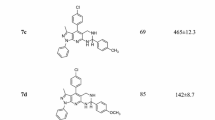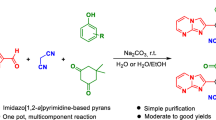Abstract
A set of unique nucleoside analogs, containing ‘spirocyclic orthoester-type’ scaffolds, were synthesized from a common isothiazolo[4,3-d]pyrimidine-riboside precursor. The key reaction, using 1,2-di-heteroatomic nucleophiles (e.g., 1,2-ethandithiol) and BF3•OEt2, converts an exocyclic imine into the spirocyclic analogs. The novel structural scaffold is confirmed through the use of one- and two-dimensional 1H and 13C NMR experiments.
Similar content being viewed by others
Main
The involvement of nucleosides and nucleotides in key cellular processes has prompted the exploration of modified analogs as antibiotics, anti-virals and anticancer agents.1, 2, 3 Bioactive nucleoside analogs were indeed some of the earliest to be isolated and numerous nucleoside-based derivatives are currently in clinical use.4, 5 Coformycin, for example, produced by Nocardia interforma and Streptomyces kaniharaensis, was isolated five decades ago by the Umezawa group and was found to be a potent adenosine deaminase inhibitor, ultimately leading to pentostatin, which is in clinical use for treating hairy cell leukemia.6 Parallel to their medicinal utility, modified nucleosides have long been recognized as biochemical and biophysical tools.7 Another classical example is puromycin, a translation inhibitor produced by Streptomyces alboniger, which acts as a mimic of acylated transfer RNA and is heavily used as a mechanistic biochemical agent.8
Whereas the above-mentioned examples rely on the biochemical function of the analogs, more recent developments have aimed to confer probing traits upon modified nucleosides and nucleotides. In particular, with the advances in fluorescence spectroscopy and instrumentation, tagged, conjugatable and fluorescent nucleoside analogs have gained increased popularity.9, 10, 11, 12, 13 Unlike their common medicinal chemistry uses as inhibitors, such probes need to maintain minimal structural and functional perturbations when replacing their native counterparts. We define nucleosides that fulfill such critical constraints as being isomorphic and isofunctional, respectively. Along this line of research, we have introduced two highly isomorphic emissive RNA alphabets, comprised of a thieno[3,4-d]pyrimidine14 and an isothiazolo[4,3-d]pyrimidine15 as the heterocyclic cores (Figure 1a). We have recently expanded these to a series of noncanonical emissive nucleoside analogs (Figure 1a).16 In the course of these studies, we have discovered intriguing reactivity patterns, which transform the aromatic heterocyclic nucleobases to non-aromatic, non-planar analogs, without altering their fundamental ring connectivity. Such modifications, generating orthoamides and alike, are generally rather rare in purine nucleoside analogs and have never been reported for the thieno and isothiazolo cores of interest here. In this communication, we thus outline the synthetic pathways leading to these analogs (Figure 1b) and the observed reactivity patterns.
The synthesis of the thieno[3,4-d]pyrimidine-based nucleosides relied on glycosylation reactions between a ribose precursor and the core thienopyrimidine heterocycle.14 In contrast, the isothiazolo[4,3-d]pyrimidine-based set of nucleosides required a bottom-up synthesis of the entire nucleosidic skeleton, starting from the sulfhydryl-containing hexose 5 (Figure 1c).15 As such the ribose-linked 5-membered isothiazole fragment was first fabricated, followed by a ring closure to the purine-mimic nucleus (Substrate 1). The unexpected reactivity was first observed from this compound during our attempts to deprotect the benzyl-protected ribose unit.
A carbamate-protected pyrimidine of this type represents a unique ring that is particularly reactive at carbon C7 (Figure 1b, labelled). We first noted unusual reactivity patterns when attempting to ultimately deprotect compound 1 to the nucleoside analog tzisoG (Figure 1a). Upon treatment of 1 with BF3•OEt2 and 1,2-ethanedithiol (X=Y=SH) in DCM, we noted that, while the debenzylation succeeded as expected, the exocyclic nitrogen N1′ (Figure 1b) was displaced with 1,2-ethanedithiol to provide 2 in 46% yield. This unique spiroheterocyclic motif was surprisingly stable to strongly Lewis acidic conditions (>30 mol equivalents). It is also worth noting that the ethoxycarbonyl group was lost over the course of the reaction. We also noted that if the ethoxycarbonyl group of 1 was removed before the attempted debenzylation reaction, the reaction was found to proceed normally without displacement of the exocyclic nitrogen, as reported.15
The formation of this unusual product is supported by a key characteristic peak in the 13C NMR spectrum. While 13C NMR data for such spirocyclic ‘orthoester-type’ moieties of formula CR1(NR2)(X1)(X2), where X is any variety of heteroatoms, are limited in literature, the spirocarbon chemical shifts generally range between δ 80 and 100 p.p.m.17, 18, 19 We have identified what we believe to be this unique carbon in compound 2 at δ 83 p.p.m. This signal is missing in the parent compounds of the isothiazolo-pyrimidine family, where this sp2 carbon peak may be typically found at δ 150–160 p.p.m. To cement this assignment, we have noted the presence of long-range coupling between this carbon and the neighboring methylene 1H NMR peaks located on the ethanedithiol unit, as identified via a HMBC experiment (Figure 2a).
Considering that, in the context of purines and analogs thereof, reactions at carbon C7 primarily occur when functionalized with good leaving groups such as halides or with harsh reagents such as POCl3, displacement of this nitrogen under mild non-enzymatic conditions (e.g., in the absence of adenosine deaminase) is intriguing. This unprecedented behavior prompted us to test the scope of this reaction through a variety of similar 1,2-heteroatom-substituted ethane-derived substrates such as ethylene glycol, cysteamine, ethylenediamine, mercaptoethanol and ethanolamine. During the course of the reaction (as aliquots were taken and subjected to ESI-MS analysis) with several substrates, we observed the presence of partially displaced intermediates similar to compound 7 (Figure 2b) containing the exocylic nitrogen as well as uncyclized substrate attached. We were, however, unable to isolate this intermediate in any of our trials. Ethylenediamine (X=Y=NH2) was the fastest substrate to react, providing 3 in 36% yield after 12 h, whereas ethylene glycol, ethanolamine and mercaptoethanol all showed little reactivity even after 72 h, likely in part due to the strong competing coordination of oxygen with BF3. Upon treatment with cysteamine (X=SH, Y=NH2), the reaction proceeded smoothly with displacement of the exocyclic nitrogen within 24 h to provide 4 with a 76% yield. No debenzylation was observed during the course of the reaction with cysteamine, which is not surprising given the necessity of a dithiol for successful deprotections as reported previously.15 Note that we also found no chromatographic or spectral evidence for the formation of a diastereomeric mixture of 4 in this reaction, but cannot unequivocally exclude this possibility. Several of these substrates were also tested in the absence of BF3•OEt2 in an effort to further gain insight into this process. Ethylenediamine reacted at the same rate regardless of the presence of BF3 and gave a yield of 34% in the absence of BF3 after 12 h. Cysteamine showed a significantly lower rate of conversion to the final product in the absence of BF3, but ultimately gave 4 in a 65% yield after 72 h. 1,2-Ethanedithiol remained completely unreactive with our substrate in the absence of BF3 after 72 h.
Given these trends, it seems that NH2 is the most reactive nucleophile in this process, which might be somewhat surprising as thiols are typically found to display higher nucleophilicity. While speculative at this stage, we propose the reasoning behind this to be in a complex relationship between the Lewis acid activator, coordinated atoms and increased ability of nitrogen to act as a hydrogen bond donor or acceptor relative to sulfur (see mechanism, Figure 2b).
In summary, we have synthesized several spirocyclic orthoester-type derivatives of our isothiazolo[4,3-d]pyrimidine analogs through the exploitation of a unique reactivity in our protected tzisoG analog. While orthoester-type functionalities have been used as protecting groups in nucleoside chemistry,20 spirocyclization of a purine scaffolds and their mimics appear to be rare. This unusual functional handle may be further explored for biological activity, as the biochemical properties of these unique structural scaffolds has yet to be explored.
References
Jordheim, L. P., Durantel, D., Zoulim, F. & Dumontet, C. Advances in the development of nucleoside and nucleotide analogues for cancer and viral diseases. Nat. Rev. Drug. Discov. 12, 447–464 (2013).
Shelton, J. et al. Metabolism, biochemical actions, and chemical synthesis of anticancer nucleosides, nucleotides, and base analogs. Chem. Rev. 116, 14379–14455 (2016).
Isono, K. Nucleoside antibiotics: structure, biological activity, and biosynthesis. J. Antibiot. 41, 1711–1739 (1988).
Galmarini, C. M., Mackey, J. R. & Dumontet, C. Nucleoside analogues and nucleobases in cancer treatment. Lancet Oncol. 3, 415–424 (2002).
de Clercq, E. Milestones in the discovery of antiviral agents: nucleosides and nucleotides. Acta Pharm. Sin. B 2, 535–548 (2012).
Nakamura, H. et al. Structure of coformycin, an unusual nucleoside of microbial origin. J. Am. Chem. Soc. 96, 4327–4328 (1974).
Suhadolnik, R. J. Nucleoside Antibiotics(Wiley, New York, NY, USA,1970)
Pestka, S. Inhibitors of ribosome functions. Annu. Rev. Microbiol. 25, 487–562 (1971).
Sinkeldam, R. W., Greco, N. J. & Tor, Y. Fluorescent analogs of biomolecular building blocks: design, properties, and applications. Chem. Rev. 110, 2579–2619 (2010).
Wilhelmsson, L. M. Fluorescent nucleic acid base analogues. Q. Rev. Biophys. 43, 159–183 (2010).
Hawkins, M. E. Fluorescent pteridine nucleoside analogs. Cell Biochem. Biophys. 34, 257–281 (2001).
Wilson, J. N. & Kool, E. T. Fluorescent DNA base replacements: reporters and sensors for biological systems. Org. Biomol. Chem. 4, 4265–4274 (2006).
Okamoto, A., Saito, Y. & Saito, I. Design of base-discriminating fluorescent nucleosides. J. Photochem. Photobiol. C 6, 108–122 (2005).
Shin, D., Sinkeldam, R. W. & Tor, Y. Emissive RNA alphabet. J. Am. Chem. Soc. 133, 14912–14915 (2011).
Rovira, A. R., Fin, A. & Tor, Y. Chemical mutagenesis of an emissive RNA alphabet. J. Am. Chem. Soc. 137, 14602–14605 (2015).
Rovira, A. R., Fin, A. & Tor, Y. Expanding a fluorescent RNA alphabet: synthesis, photophysics and utility of isothiazole-derived purine nucleoside surrogates. Chem. Sci. 8, 2983–2993 (2017).
Li, W. S. & Sayre, L. M. Reaction of amines with N1,N10-ethylene-bridged flavinium salts: the first NMR spectroscopic evidence of C10a tetrahedral amine adducts. Tetrahedron 57, 4523–4536 (2001).
Nikolaev, V. V., Heimgartner, H., Linden, A., Krylov, I. S. & Nikolaev, V. A. RhII-catalyzed reactions of diazocarbonyl compounds with dicarboximides. Eur. J. Org. Chem. 2006, 4737–4746 (2006).
Weisman, G. R., Johnson, V. & Fiala, R. E. Tricyclic orthoamides: effects of lone-pair orientation upon NMR spectra. Tetrahedron Lett. 21, 3635–3638 (1980).
Sekine, M. & Hata, T. Cyclic orthoester functions as new protecting groups in nucleosides. J. Am. Chem. Soc. 105, 2044–2049 (1983).
Acknowledgements
We thank the National Institutes of Health for generous support (via grant number GM 069773), the Chemistry and Biochemistry MS Facility and the UCSD NMR Facility.
Author information
Authors and Affiliations
Corresponding author
Ethics declarations
Competing interests
The authors declare no conflict of interest.
Additional information
Dedicated to Professor KC Nicolaou for his contributions to synthetic organic chemistry.
Supplementary Information accompanies the paper on The Journal of Antibiotics website
Supplementary information
Rights and permissions
About this article
Cite this article
Rovira, A., Tor, Y. Synthesis of unique spirocyclic orthoester-type derivatives of isothiazolo[4,3-d]pyrimidine nucleosides. J Antibiot 71, 342–344 (2018). https://doi.org/10.1038/ja.2017.87
Received:
Revised:
Accepted:
Published:
Issue Date:
DOI: https://doi.org/10.1038/ja.2017.87
- Springer Japan KK






